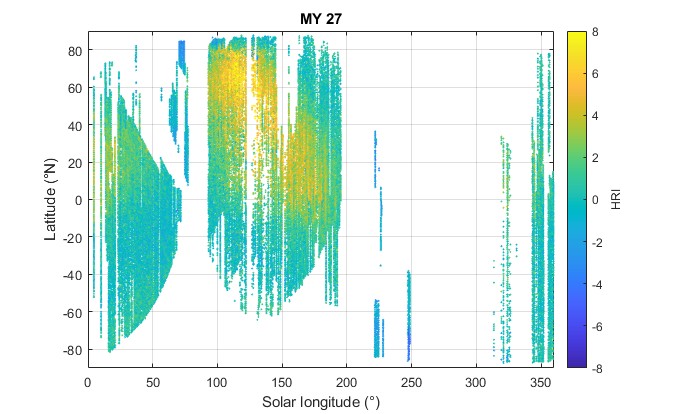First Planetary Science Application of the Hyperspectral Range Index: Water Vapor as Observed by PFS/MarsExpress
- 1Université Libre de Bruxelles, SQUARES, 50 Av. F.D. Roosevelt, Brussels, Belgium
- 2Institut de Physique du Globe de Paris, Planetary and Space Science, Paris, France
- 3Istituto di Astrofisica e Planetologia Spaziali (IAPS/INAF), Rome, Italy
Thanks to successful long-lasting missions (e.g. Mars Express) and the launch of new space missions (e.g. ExoMars), the amount of Mars’ atmosphere remote sensing observations currently available has significantly increased, allowing to study the planet in greater details than ever before. The methods used to analyze these space observations are generally based on iterative approaches, for which the radiative transfer is solved at each iteration and can become time-consuming when applied to large datasets. This has motivated us to try applying an alternative method developed for the detection and quantification of trace gases in the Earth’s atmosphere, and which will be presented. This detection method is based on the calculation of a spectrally integrated index, called “hyperspectral range index" (HRI), which represents the strength of the spectral signature of the targeted atmospheric species in a spectral range. The HRI yields a dimensionless scalar and is calculated as
with K the Jacobian of the target species, Sy a covariance matrix generated from a representative set of spectra that do not include the target species spectral signature, and ȳ the mean spectrum of the covariance matrix. In that context, Sy is a statistical characterization of the expected correlations between the spectral channels in the absence of the target species. The HRI can encompass broad spectral ranges to exploit all the channels in which the target species is absorbing, which results in a substantial gain of sensitivity over other detection methods and makes it suitable for the detection of broadband absorption features. As the HRI can lead to false detections in case of partial match between spectral signatures of the target species and an interference, a firm identification of the target species is needed to confirm its contribution to the HRI. To do so, a transformation, referred to as whitening, has been applied.
The method has been tested on nadir observations of the PFS (Planetary Fourier Spectrometer, Giuranna et al., 2021) instrument onboard Mars Express. The spectral range 350-500 cm-1has been exploited to calculate the H2O vapor HRI. The covariance matrix and its associated mean spectrum have been built using spectra recorded in regions known to be depleted in water vapor. Using these, the HRI has then been calculated for the entire PFS dataset. Seasonal distributions have been built (an example is shown on Figure 1 for the Martian Year 27) and will be discussed.

As the HRI value depends on the H2O abundance in Mars’ atmosphere, it is possible to convert it to an integrated column. For this, we have built an artificial feedforward neuronal network (NN) that will be presented. The use of a NN allows us to take into account the different parameters affecting the HRI value in addition to the water column, such as the temperature profile and the surface temperature. These parameters are included as input parameters of the NN. The NN has been trained with more than 200,000 forward-simulated PFS spectra with the line-by-line Atmosphit radiative-transfer code (Coheur et al., 2005) using PFS-L2 auxiliary data, which values are randomly selected to be fully representative of real Martian conditions. Still under analysis, the NN yields a target gas total column per single PFS measurement, for which the uncertainties are estimated by propagating the uncertainties associated with each input variable through the NN.
How to cite: Es-Sayeh, M., Bauduin, S., Clarisse, L., Franco, B., and Giuranna, M.: First Planetary Science Application of the Hyperspectral Range Index: Water Vapor as Observed by PFS/MarsExpress, Europlanet Science Congress 2024, Berlin, Germany, 8–13 Sep 2024, EPSC2024-1099, https://doi.org/10.5194/epsc2024-1099, 2024.